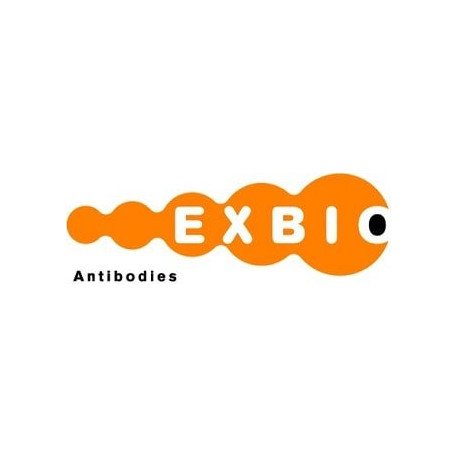Cart 0 Product Products (empty)
No products
To be determined Shipping
0,00 € Total
Prices are tax excluded
Product successfully added to your shopping cart
Quantity
Total
There are 0 items in your cart. There is 1 item in your cart.
Total products (tax excl.)
Total shipping (tax excl.) To be determined
Total (tax excl.)
Data sheet of Mouse Monoclonal to CD5 / T1
| Brand | Exbio |
| Product type | Primary antibodies |
| Reactivity | Human |
| Clonality | Monoclonal |
More info about Mouse Monoclonal to CD5 / T1
| Brand: | Exbio |
| Product no.: | 11-204-C025 |
| Product type: | Primary antibodies |
| Host species: | Mouse |
| Product name: | Mouse Monoclonal to CD5 / T1 |
| Antigen: | CD5 |
| Clonality: | Monoclonal |
| Clone: | MEM-32 |
| Isotype: | IgG1 |
| Immunogen: | Crude thymus membrane fraction. |
| Format: | purified |
| Specificity: | The antibody MEM-32 reacts with the cell surface glycoprotein CD5, a 67kDa single-chain transmembrane glycoprotein expressed on mature T-lymphocytes, most of thymocytes and B-lymphocytes subset (B-1a lymphocytes). HLDA III; WS Code T 523 _x000D_ |
| Categories: | CD and Related Antigens (Human) |
| Concentration: | 1 mg/ml |
| Storage buffer: | Phosphate buffered saline (PBS) with 15 mM sodium azide, approx. pH 7.4 |
| Storage / stability: | Store at 2-8°C. Do not freeze. Do not use after expiration date stamped on vial label. |
| Background: | CD5 antigen (T1; 67 kDa) is a human cell surface T-lymphocyte single-chain transmembrane glycoprotein. CD5 is expressed on all mature T-lymphocytes, most of thymocytes, subset of B-lymphocytes and on many T-cell leukemias and lymphomas. It is a type I membrane glycoprotein whose extracellular region contains three scavenger receptor cysteine-rich (SRCR) domains.The CD5 is a signal transducing molecule whose cytoplasmic tail is devoid of any intrinsic catalytic activity. CD5 modulates signaling through the antigen-specific receptor complex (TCR and BCR). CD5 crosslinking induces extracellular Ca++ mobilization, tyrosine phosphorylation of intracellular proteins and DAG production. Preliminary evidence shows protein associations with ZAP-70, p56lck, p59fyn, PC-PLC, etc. CD5 may serve as a dual receptor, giving either stimulatory or inhibitory signals depending both on the cell type and development stage. In thymocytes and B1a cells seems to provide inhibitory signals, in peripheral mature T lymhocytes it acts as a costimulatory signal receptor. CD5 is the phenotypic marker of a B cell subpopulation involved in the production of autoreactive antibodies.Disease relevance: CD5 is a phenotypic marker for some B cell lymphoproliferative disorders (B-CLL, Hairy cell leukemia, etc.). The CD5+ popuation is expanded in some autoimmune disorders (Rheumatoid Arthritis, etc.). Herpes virus infections induce loss of CD5 expression in the expanded CD8+ human T cells. |
| Purity: | > 95% (by SDS-PAGE) |
| Purification: | Purified by protein-A affinity chromatography |
| Product specific references: | *Hrdinka M, Dráber P, Stepánek O, Ormsby T, Otáhal P, Angelisová P, Brdicka T, Paces J, Horejsà V, Drbal K: PRR7 is a transmembrane adaptor protein expressed in activated T cells involved in regulation of T cell receptor signaling and apoptosis. J Biol Chem. 2011 Jun 3;286(22):19617-29., *Horejsi V et al.: Monoclonal antibodies against human leucocyte antigens. I. Antibodies against beta-2-microglobulin, immunoglobulin kappa light chains, HLA-DR-like antigens, T8 antigen, T1 antigen, a monocyte antigen, and a pan-leucocyte antigen. Folia Biol. (Praha) 32, 12 (1986)., *Leukocyte Typing III., McMichael A. J. et al. (Eds.), Oxford University Press (1987). |
| General references: | Raman C.: CD5, an important regulator of lymphocyte selection and immune tolerance. Immunol Res. 2002;26(1-3):255-63., *Freedman AS, Freeman G, Whitman J, Segil J, Daley J, Levine H, Nadler LM: Expression and regulation of CD5 on in vitro activated human B cells. Eur J Immunol. 1989 May;19(5):849-55. _x000D_ |
| Related products: | - Mouse Monoclonal to CD53 - Mouse Monoclonal to CD50 / ICAM-3 - Mouse Monoclonal to CD52 / CAMPATH-1 |
| Shipping condition: | Room temperature |


